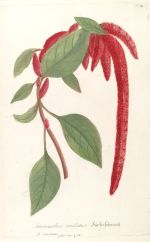Amaranthus:
Love Lies Seeding
By Audrey Stallsmith

In paradise, fast by the tree of life,
Began to bloom; but soon for man's offence
To heaven removed. . .
John Milton, Paradise Lost
The Aztecs ate amaranth's protein-rich seeds to increase their energy and stamina. But they also mixed those crushed seeds with honey and the blood of human sacrifices to form edible idols.
This practice was (justifiably) frowned upon by the Spanish conquerors, though it may give a whole new meaning to love-lies-bleeding! So the conquistadors prohibited the cultivation of amaranthus. But, fortunately, the plant is very good at surviving on its own. Modern Mexicans make less controversial treats by mixing its popped seeds with honey, molasses, or chocolate and calling those confections alegria ("joy").
Amaranth's persistence can probably be attributed to its lavish production of seeds--up to 60,000 or so per plant. Though I doubt that anybody has ever actually counted!
Depending on whom you believe, amaranthus either derives from the Greek amarantos ("unfading") and anthos ("flower") or from the Greek a ("not") and marainean ("to waste away"). In either case, the reference is to flowers that last forever, such as the velvety chenille-like ropes of love-lies-bleeding (amaranthus caudatus, AKA tassel flower and nun's scourge).
In the Language of Flowers love-lies-bleeding, naturally enough, stands for "hopeless" and "heartless." Other popular garden varieties of amaranthus are cruentus (AKA prince's feather) and tricolor--grown for its multi-hued leaves and better known as Joseph's Coat.
Prince's feather is also one of the grain amaranths--cultivated for its production of seeds. Though not officially grains, those seeds can be ground into flour, boiled like rice, pressed into flakes, popped like popcorn, or brewed into a beer called chica. Because amaranth is not a member of the grass family, it contains no gluten and thus can be a godsend to the gluten intolerant.
Amaranth seeds are also much more nutritious than most grains, being high in protein and amino acids, as well as fiber and several vitamins. They also help lower cholesterol.
The plant's greens and white roots can be cooked as vegetables too, though the fact that those leaves are high in oxalic acid may cause problems for some people. Not to mention that, in ancient times, amaranth was used to curb the affections, which could cause a few problems as well!
Some of the worst weeds in the world--the notorious pigweeds--are also members of the amaranthus family. So that muchness of seeds is not always a good thing! But the ability of amaranthus to grow anywhere weeds can may someday help feed that part of the world where grains require irrigation to thrive. In fact, in The Green Pharmacy Anti-Aging Prescription, James Duke and Michael Castleman list it as one of the seven wonder weeds.
Organic gardeners like to plant amaranthus too. Not just for those unusual flowers and because Rodale highly recommended it, but because it attracts ground beetles. And those beetles are "good guy" bugs, who will help run the more villainous types--such as cutworms, slugs, etc.--out of town.
Since amaranth is astringent, it is supposed to be able to stop diarrhea or bleeding, and has also been used as a wash for skin problems. So maybe it should really be called "love lies not bleeding!".
All this talk of love bleeding or curbed may appear to make amaranthus inappropriate for Valentine's Day. But, in his poem, "A Vow to Heavenly Venus," Joachim du Bellay pens a sentiment we all can share. "May Love, we pray, like amaranthine flowers, feel no decay."
Amaranthus caudatus image is from Phytanthoza Iconographia, courtesy of the Missouri Botanical Garden.








